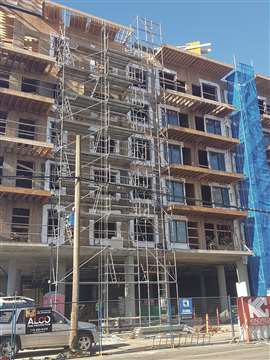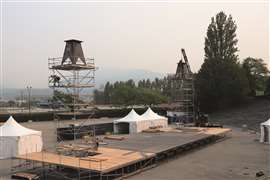SAIA’s newest council is getting Canada on the same page
06 September 2023
 Crews work on a high-rise condo building under construction in Toronto. Regulations for height limits, equipment and other specifications can differ greatly from province to province. (Photo: Reuters/Carlos Osorio)
Crews work on a high-rise condo building under construction in Toronto. Regulations for height limits, equipment and other specifications can differ greatly from province to province. (Photo: Reuters/Carlos Osorio)
The mission of the SAIA’s Canadian Council is straightforward: to unify, represent and enhance resources for each province in the scaffold and access industry across Canada.
Complicating the council’s charge is the lack of a nationally standardized set of rules and requirements across the country’s 10 provinces and three territories.
Unlike the U.S. – which employs the Department of Labor and its Occupational Safety and Health Administration (OSHA) to create, publish and enforce federal regulations that apply to all 50 states – Canada’s regions have their own provincial regulating bodies that independently develop their own standards.
Yes, entities such as the Canadian Standards Association (CSA) operate as an accredited national body, and some provinces recognize CSA scaffold and access standards.
But other regions don’t acknowledge CSA rules outright or bring in just one or two specific statements or clauses from a CSA standard, the latter of which can lead to a loss of context in trying to capture the underlying principle behind the referenced standard.
The absence of uniformity among Canada’s provinces and territories can be problematic for the country’s scaffolding and construction companies, according to SAIA Canadian Council Chair Rick McKinlay, PMP.
“What we find, more often than not, is that though I’d like to think that [these different provinces] communicate with one another, there is certainly is a perception that isn’t the case,” says McKinlay, who is also president of the Scaffold Industry Association of Canada (SIAC)’s Ontario chapter.
Getting Canada’s provinces and territories on the same page with these scaffold and access regulations has been the main undertaking of the SAIA’s Canadian Council since its inception in January 2021.
And just like the council’s mission, the solution is straightforward: a gap analysis tool in the form of a spreadsheet.
Challenges along the way
Developing the tool has not been a simple assignment. McKinlay says the Canadian Council, one of 12 SAIA councils, started with a small team researching scaffolding and access standards across provinces and territories, identifying the relevant ones and pulling them for the initial gap analysis framework.
 Scaffolding adorns a building in British Columbia. (Photo: Canada Scaffold)
Scaffolding adorns a building in British Columbia. (Photo: Canada Scaffold)
With tabs organizing the document by scaffold and access equipment types and disciplines, the gap analysis is intended to be an easier vehicle for professionals across Canada to look up sub-topics (such as height limits and machine dimension requirements) and check them against the spreadsheet’s columns, which signify the country’s separate provinces and territories.
“So, if you’re working in shoring, you’d be able to go to the shoring tab or page and follow the sheet across and say, ‘OK, these are the differences between all these provinces,’” McKinlay says. “It sounds easy, but it wasn’t [before].”
The tool also includes links to the reference documents where the council’s researchers found the standards information, and these sources range from organizations such as the CSA to PDFs of construction regulations on a province’s official website.
“What we wanted was an at-a-glance tool,” McKinlay says. “We wanted the reader to be able to quickly determine what the differences are from region to region for each of the different types of scaffold and access equipment.”
Rather than copying and pasting the regulations verbatim, the team’s task has been rewriting and boiling the information down to show only the key requirements for each type of scaffold and access equipment.
Straight-forward language
Regurgitating the standards as written in the reference documents would continue the original problem of an overabundance of language and information in the tool. In addition, the team rewrites the information from the reference sources to cut down on verbiage that can come across as hard-to-process legalese.
“The way regulations are written, you have to be a regulator in order to really understand them,” McKinlay says.
Over the past two-plus years, McKinlay says the research team that populates the tool has grown to 12-14 regional experts who hail from Halifax to Vancouver and are affiliated with both the SAIA and the SAIC.
Currently, the gap analysis features standards from eight Canadian provinces: British Columbia, Alberta, Saskatchewan, Manitoba, Ontario, Quebec, New Brunswick and Nova Scotia.
McKinlay says the council plans on adding regulatory information from the remaining regions (Prince Edward Island, Newfoundland and Labrador, Yukon, Northwest Territories and Nunavut), and the council’s goal is to debut the first draft of the gap analysis document at the 2023 SAIA Annual Convention & Exposition in Vancouver in October.
Avoiding confusion and penalties
With globalization encouraging companies to broaden their market base beyond their home cities and regions, the differences in scaffold and access standards across Canada can become problematic.
“It is often very confusing for Canadian companies when considering broadening their market base,” McKinlay says.
 Workers set up scaffolding on the Lions Gate Bridge in Vancouver. The SAIA Canadian Council has developed a gap analysis tool for deciphering the differences in regulations and standards across the country’s provinces. (Photo: Reuters/Andy Clark)
Workers set up scaffolding on the Lions Gate Bridge in Vancouver. The SAIA Canadian Council has developed a gap analysis tool for deciphering the differences in regulations and standards across the country’s provinces. (Photo: Reuters/Andy Clark)
McKinlay and his SAIA Canadian Council Co-Chair Christopher Jones gave a very concrete example of how regulations in separate provinces can differ severely – and the costs that can accompany regulation infractions.
If Jones, who is the general manager of the British Columbia-based scaffold and access equipment supplier Canada Scaffold, wanted to set up operations in Toronto (approximately 2500 miles east in Ontario) to take advantage of the high-rise, high-density residential construction boom, he would need to do a lot of research on the differences between his current market and his new one.
For example, the Vancouver market abides by CSA standards that allow crews to use bosun’s chair access up to a suspension height of 150 meters (492 feet) with adequate stabilization measures.
If Jones’ company opened operations in the Toronto market, where local regulations limit chair access – regardless of stabilization – to a suspension height of 90 meters (295 feet), he would need to research that difference in standards before starting the project.
Without adjusting for the new height limit, Jones and Canada Scaffold might be subjected inadvertently to a citation or fine.
“And up until now, there have been little to no resources available other than Jones himself taking the undertaking of going through all the different regulations and sifting through,” McKinlay says. “So, an outside party coming in and accustomed to their own home market regulations could find themselves inadvertently in a punishable offense situation without even having been aware of it.
“How is the Vancouver company to know this at the outset?” he says. “The answer comes in the form of this gap analysis tool.”
 Crews from the British Columbia-based Canada Scaffold construct a stage and towers for a Red Bull event. (Photo: Canada Scaffold)
Crews from the British Columbia-based Canada Scaffold construct a stage and towers for a Red Bull event. (Photo: Canada Scaffold)
A living document
Creating a gap analysis tool is a big first step in streamlining the process of researching the institutional and regulatory differences between provinces.
But laws and standards can change, and McKinlay says the spreadsheet is set to adapt to those new rules over time.
“For the gap analysis tool, one of the things that we all agreed on [as the Canadian Council] is that it’s a living, breathing thing,” McKinlay says. “We’re not creating something, putting a few years’ worth of effort into it and then filing it in a folder somewhere and never looking at it again.”
He says the council has appointed members as owners of the content for each geographic region, and these owners will continue updating the gap analysis through periodic reviews as local Canadian governments amend construction regulations and legislation.
The key to keeping the spreadsheet fresh and up to date is communication, which is the driving force behind the gap analysis project overall.
“We need to help each other; we need to talk to each other,” Jones says. “We all have the same problems. We can’t find those out unless we communicate with each other.”
Learn more from the SAIA Canadian Council by listening to the latest ALH podcast episode.
STAY CONNECTED



Receive the information you need when you need it through our world-leading magazines, newsletters and daily briefings.
CONNECT WITH THE TEAM








